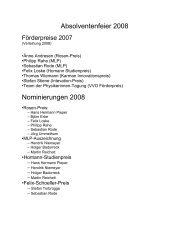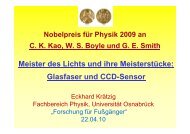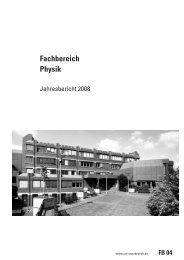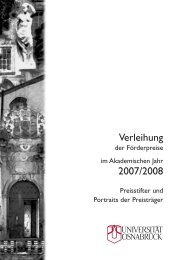Universität Osnabrück, Graduiertenkolleg Mikrostruktur oxidischer
Universität Osnabrück, Graduiertenkolleg Mikrostruktur oxidischer
Universität Osnabrück, Graduiertenkolleg Mikrostruktur oxidischer
Sie wollen auch ein ePaper? Erhöhen Sie die Reichweite Ihrer Titel.
YUMPU macht aus Druck-PDFs automatisch weboptimierte ePaper, die Google liebt.
18 UNIVERSITÄT OSNABRÜCK, FACHBEREICH PHYSIK<br />
this system is a non-saturated spin-fluctuation system. The exchange-enhancement factors are not high enough<br />
to lead to the saturation of the amplitude of the local spin fluctuations.<br />
In the case of GdNi5-xAlx system, the aim of our study was to investigate the influence of partially replacing Ni<br />
by Al on the magnetic state of the Ni 3d-electrons in GdNi5-xAlx by using magnetic measurements and XPS<br />
technique.<br />
The valence bands of GdNi5, GdNi4Al (Fig 4) arise mainly from the Ni 3d electrons which are close to the onset<br />
of ferromagnetism. The 3d states are hybridized with 5d states. The occupied part of the valence bands are over<br />
4eV wide. One can see also a marked feature near the maximum of<br />
the valence bands of GdNi5 and GdNi4Al. This may be explained<br />
Intensity (arb. units)<br />
GdNi 5<br />
GdNi 4 Al<br />
GdNiAl 4<br />
pure Ni<br />
-2 0 2 4 6 8 10 12 14 16<br />
Binding energy (eV)<br />
as a partial quenching of the spin fluctuations by the strong magnetic<br />
moments of Gd atoms. Furthermore, the substitution of Ni by<br />
Al leads to an increase of the localization of the Ni 3d electrons,<br />
reflected by an energy shift of the valence band maximum to<br />
higher binding energies. This is also supported by the different<br />
values of the saturation temperature of the spin fluctuations T *<br />
obtained for GdNi5 and GdNi4Al.<br />
Fig 4. XPS valence spectra of the GdNi5-xAlx system.<br />
One can observe marked differences both in the shape and in the<br />
position of the valence bands in GdNiAl4 and Ni. The density of states at the Fermi level in GdNiAl4 is drastically<br />
reduced in comparison with pure Ni and the maximum of the valence band is shifted to higher binding<br />
energy, namely from 0.59 eV in Ni to 2.3eV in GdNiAl4. The states at the Fermi level have 3d and s-p character<br />
in Ni and GdNiAl4, respectively. In d-band metals and alloys the 3d states are shifted gradually to higher binding<br />
energy by increasing the d-state occupancy and consequently a decreasing density of states at EF occurs. These<br />
results reveal the complete filling of the Ni 3d-band by charge transfer of Gd 5d electrons and the s-p character<br />
of the states at the Fermi level in GdNiAl4. This conclusion is also confirmed by comparing the Ni 2p core level<br />
spectra for pure Ni and GdNiAl4. In the Ni 2p core level spectrum of pure Ni are present also satellites as an<br />
evidence for the d character in unoccupied states. The absence of these satellites in the Ni 2p spectrum of<br />
GdNiAl4, shows that the 3d-band in this compound is filled.<br />
Summarising the results, one may conclude that the Ni 3d-band in GdNi5-xAlx compounds is sensitive to the<br />
local environment, showing a large variety of magnetic behaviours by partially replacing Ni by Al atoms.<br />
Outlook<br />
We have very recently investigated the presented ferric-wheel by X-ray emission spectroscopy using synchrotron<br />
radiation. The results will be further analysed. Other magnetic molecules will be investigated by several<br />
spectroscopic methods in the next future. Other rare-earth compounds under investigation are the LaNi5-xAlx and<br />
YCo2-xSix series.<br />
References<br />
[1] See http://zeus.physik.uni-osnabrueck.de/neumann/veroeff_1.html<br />
[2] St. Uhlenbrock, PhD Thesis, <strong>Osnabrück</strong> 1994<br />
[3] S. Lütkehoff, PhD Thesis, <strong>Osnabrück</strong> 1997<br />
[4] S. Plogmann, PhD Thesis, <strong>Osnabrück</strong>, 2000<br />
[5] A review on http://cmpweb.ameslab.gov/magnetic_molecules/<br />
[6] C. Schröder, PhD Thesis, <strong>Osnabrück</strong> 1999<br />
[7] E. Burzo, S.G. Chiuzbăian, L. Chioncel, M. Neumann, Journal of Physics: Condensed Matter, 12 (2000)<br />
5897<br />
[8] D. Ginoux, D. Givord, and A del Moral, Solid State Communications 19 (1978) 891<br />
[9] J. Palleau and G. Chouteau, Physical Review Letters 41 (1980) L227<br />
[10] M. Coldea, S. Chiuzbaian, M. Neumann, D. Todoran, M. Demeter, R. Tetean, V. Pop, accepted for publication<br />
in Acta Physica Polonica<br />
[11] T. Moriya, Journal of Magnetism and Magnetic Materials 100 (1991) 261 and the references therein<br />
[12] A. Caneschi, D. Gatteschi, C. Sangregorio, R. Sessoli, L. Sorace, A. Cornia, M.A. Novak, C. Paulsen, W.<br />
Wernsdorfer, J. Magn. Magn. Mater. 200 (1999) 182







